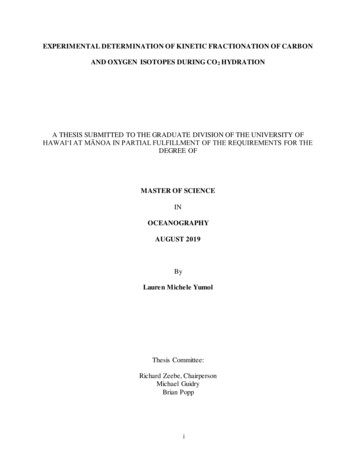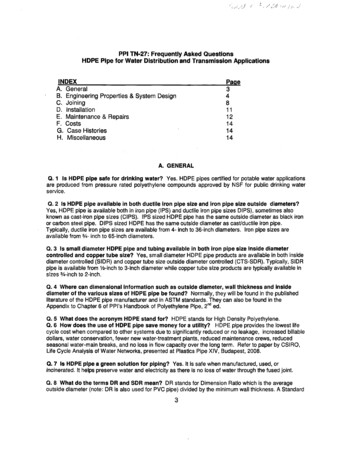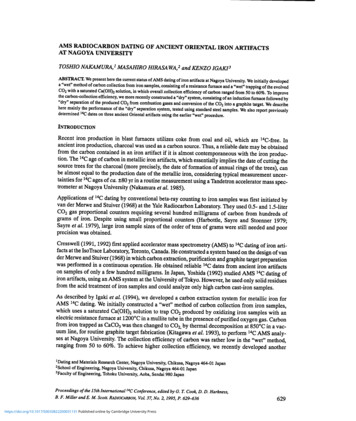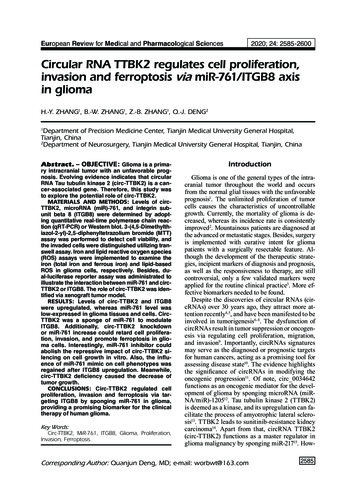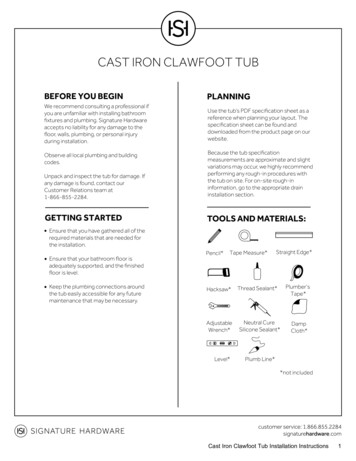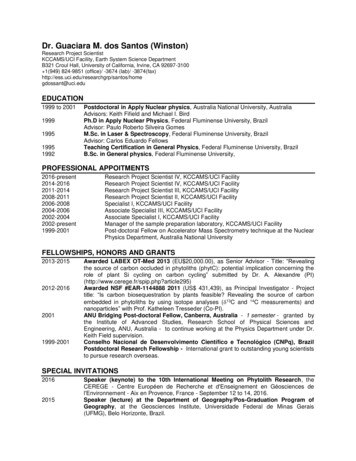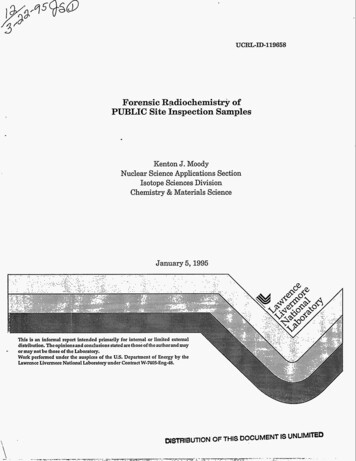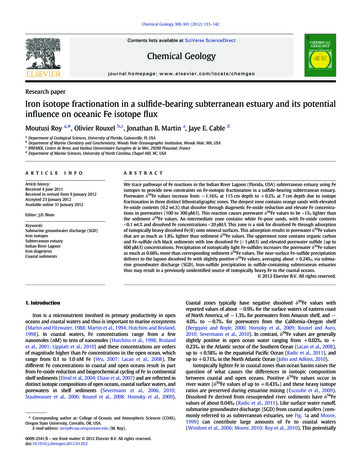
Transcription
Chemical Geology 300-301 (2012) 133–142Contents lists available at SciVerse ScienceDirectChemical Geologyjournal homepage: www.elsevier.com/locate/chemgeoResearch paperIron isotope fractionation in a sulfide-bearing subterranean estuary and its potentialinfluence on oceanic Fe isotope fluxMoutusi Roy a,⁎, Olivier Rouxel b, c, Jonathan B. Martin a, Jaye E. Cable daDepartment of Geological Sciences, University of Florida, Gainesville, FL USADepartment of Marine Chemistry and Geochemistry, Woods Hole Oceanographic Institution, Woods Hole, MA, USAIFREMER, Centre de Brest, and Institut Universitaire Européen de la Mer, 29280 Plouzané, FrancedDepartment of Marine Sciences, University of North Carolina, Chapel Hill, NC, USAbca r t i c l ei n f oArticle history:Received 4 June 2011Received in revised form 9 January 2012Accepted 23 January 2012Available online 31 January 2012Editor: J.D. BlumKeywords:Submarine groundwater discharge (SGD)Iron isotopesSubterranean estuaryIndian River LagoonIron diagenesisCoastal sedimentsa b s t r a c tWe trace pathways of Fe reactions in the Indian River Lagoon (Florida, USA) subterranean estuary using Feisotopes to provide new constraints on Fe-isotopic fractionation in a sulfide-bearing subterranean estuary.Porewater δ56Fe values increase from 1.16‰ at 115 cm depth to 0.2‰ at 7 cm depth due to isotopefractionation in three distinct lithostratigraphic zones. The deepest zone contains orange sands with elevatedFe-oxide contents (0.2 wt.%) that dissolve through diagenetic Fe-oxide reduction and elevate Fe concentrations in porewaters (100 to 300 μM/l). This reaction causes porewater δ56Fe values to be 1‰ lighter thanthe sediment δ56Fe values. An intermediate zone contains white Fe-poor sands, with Fe-oxide contentsb 0.1 wt.% and dissolved Fe concentrations b 20 μM/l. This zone is a sink for dissolved Fe through adsorptionof isotopically heavy dissolved Fe(II) onto mineral surfaces. This adsorption results in porewater δ56Fe valuesthat are as much as 1.8‰ lighter than sediment δ56Fe values. The uppermost zone contains organic carbonand Fe-sulfide rich black sediments with low dissolved Fe (b 1 μM/l) and elevated porewater sulfide (up to600 μM/l) concentrations. Precipitation of isotopically light Fe-sulfides increases the porewater δ56Fe valuesas much as 0.68‰ more than corresponding sediment δ56Fe values. The near-surface Fe-sulfide precipitationdelivers to the lagoon dissolved Fe with slightly positive δ56Fe values, averaging about 0.24‰, via submarine groundwater discharge (SGD). Iron-sulfide precipitation in sulfide-containing subterranean estuariesthus may result in a previously unidentified source of isotopically heavy Fe to the coastal oceans. 2012 Elsevier B.V. All rights reserved.1. IntroductionIron is a micronutrient involved in primary productivity in openoceans and coastal waters and thus is important to marine ecosystems(Martin and Fitzwater, 1988; Martin et al., 1994; Hutchins and Bruland,1998). In coastal waters, Fe concentrations range from a fewnanomoles (nM) to tens of nanomoles (Hutchins et al., 1998; Brulandet al., 2001; Lippiatt et al., 2010) and these concentrations are ordersof magnitude higher than Fe concentrations in the open ocean, whichrange from 0.1 to 1.0 nM Fe (Wu, 2007; Lacan et al., 2008). Thedifferent Fe concentrations in coastal and open oceans result in partfrom Fe-oxide reduction and biogeochemical cycling of Fe in continentalshelf sediments (Elrod et al., 2004; Chase et al., 2007) and are reflected indistinct isotopic compositions of open oceans, coastal surface waters, andporewaters in shelf sediments (Severmann et al., 2006, 2010;Staubwasser et al., 2006; Rouxel et al., 2008; Homoky et al., 2009).⁎ Corresponding author at: College of Oceanic and Atmospheric Sciences (COAS),Oregon State University, Corvallis, OR, USA.E-mail address: mroy@coas.oregonstate.edu (M. Roy).0009-2541/ – see front matter 2012 Elsevier B.V. All rights reserved.doi:10.1016/j.chemgeo.2012.01.022Coastal zones typically have negative dissolved δ56Fe values withreported values of about 0.9‰ for the surface waters of eastern coastof North America, of 1.3‰ for porewaters from Amazon shelf, and 4.0‰ to 0.7‰ for porewaters from the California–Oregon shelf(Bergquist and Boyle, 2006; Homoky et al., 2009; Rouxel and Auro,2010; Severmann et al., 2010). In contrast, δ56Fe values are generallyslightly positive in open ocean water ranging from 0.02‰ to 0.23‰ in the Atlantic sector of the Southern Ocean (Lacan et al., 2008),up to 0.58‰ in the equatorial Pacific Ocean (Radic et al., 2011), andup to 0.71‰ in the North Atlantic Ocean (John and Adkins, 2010).Isotopically lighter Fe in coastal zones than ocean basins raises thequestion of what causes the differences in isotopic compositionbetween coastal and open oceans. Positive δ 56Fe values occur inriver water (δ 56Fe values of up to 0.43‰) and these heavy isotoperatios are preserved during estuarine mixing (Escoube et al., 2009).Dissolved Fe derived from resuspended river sediments have δ 56Fevalues of about 0.04‰ (Radic et al., 2011). Like surface water runoff,submarine groundwater discharge (SGD) from coastal aquifers (commonly referred to as subterranean estuaries, see Fig. 1a and Moore,1999) can contribute large amounts of Fe to coastal waters(Windom et al., 2006; Moore, 2010; Roy et al., 2010). This potentially
134M. Roy et al. / Chemical Geology 300-301 (2012) 133–142aScale0.5 m10 mShorelinePorewaterExchange0.05 m /day/mBrackish Lagoon WaterTerrestrial fresh ea culationricre810 0'00'' WcNShorelineIRL28 0'00'' NN0IndianRiver2040kilometerster interfaceCIRL39Brevard0t-waEGN3028 0'00'' NOscolamenEGN20EGN22.50sediEGN10280 30'00'' N Orange028 30'00'' NEGN0AtlanticOcean810 0'00'' WFig. 1. Location and hydrology of the Indian River Lagoon (Florida, USA) subterranean estuary. a. Hydrology of the subterranean estuary. The black wide dashed line represents the freshwater–saltwater boundary at 300 mM chloride concentrations. Flows of submarine groundwater discharge (SGD) are shown by gray arrows and incorporate terrestrial fresh SGD andmarine saline SGD, which includes both recirculated water at the sediment–water interface and recirculated water at the freshwater–saltwater boundary. Mixing between fresh and salineSGD creates the subterranean estuary (area under the dotted line). b. Geographic location of the study site. c. Position and relative lengths of porewater multisamplers in the transect.large source of SGD-derived Fe to coastal oceans may influence theirisotope signatures, depending on the isotope ratios of the Fe flux.The only previous study of Fe isotope ratios within a subterraneanestuary was conducted in Waquoit Bay, Massachusetts (Rouxel et al.,2008). At this site, negative porewater δ 56Fe values (down to 4.91‰) were found to result from the combination of twodiagenetic pathways: 1) dissimilatory Fe(III)-oxide reduction at thefreshwater–saltwater boundary of the subterranean estuary thatacts as the major source of dissolved Fe(II) and decreases dissolvedδ 56Fe values by 1‰ relative to slightly fractionated groundwater( 0.5‰); and 2) oxidative precipitation of dissolved Fe(II) as solidFe(III)-oxides, which acts as a sink for dissolved Fe(II), resulting in afurther decrease in the dissolved δ 56Fe values by 2 to 5‰(Rouxel et al., 2008). Processes that control Fe diagenesis vary fromone subterranean estuary to another and thus Fe isotope ratios shoulddiffer between subterranean estuaries. These processes includeconcentrations of dissolved oxygen (DO), sulfate (SO42 ), sulfide (S2 ),dissolved organic carbon (DOC), changes in pH, hydrologic mixingbetween hypoxic fresh groundwater and oxic water column, aerationof porewater from wave, tidal pumping and bioirrigation, whichsupplies DO, SO42 and labile marine DOC from water column (Martinet al., 2004, 2006; Charette et al., 2005; Meile et al., 2005; Spiteri et al.,2006, 2008a,b; Santos et al., 2008; Beck et al., 2010; Roy et al., 2010).Waquoit Bay porewaters have little DOC and no SO42 reduction, aprocess common to most subterranean estuaries. Precipitation of Fesulfide fractionates lighter Fe isotopes into the solid phase, therebyincreasing the δ 56Fe values of the dissolved Fe(II) (Butler et al.,2005; Severmann et al., 2006; Bennett et al., 2009; Guilbaud et al.,2011). Consequently, sulfidic subterranean estuaries could contributeheavy Fe isotopes to coastal waters, thereby potentially influencingopen ocean δ 56Fe values. Both Fe-oxide reduction and Fe-sulfideprecipitation can occur in subterranean estuaries so that the δ 56Fevalues of dissolved Fe(II) would depend on the dominating diageneticpathway, whereby positive values would occur when Fe-sulfidereaction dominates or negative δ 56Fe values would occur when Feoxide reduction dominates (Severmann et al., 2006).We report here δ 56Fe values for porewaters and sediments in thesubterranean estuary in Indian River Lagoon, Florida. At this location,SO42 reduction produces S 2 , which reacts with dissolved Fe(II) andprecipitates Fe-sulfides (Roy et al., 2010). Iron-oxide reductionproduces dissolved Fe(II) below the zone of Fe-sulfide precipitationand this dissolved Fe(II) flows upward with SGD. We use thedifferences between sediment and porewater δ 56Fe values to identifythe pathways of Fe diagenesis and isotopic signature of SGD-derivedFe. This study provides new constraints on Fe-isotopic compositionof a sulfide-bearing subterranean estuary.2. Location, sampling and backgroundIndian River Lagoon is located along the east coast of Florida andthe study site (28 08.0′ N and 80 37.5′ W) is in the central part ofthe lagoon (Fig. 1b). The subterranean estuary of Indian River Lagooncontains sediments representing two distinct depositional environmentsincluding estuarine organic matter-rich black sediments near thesediment–water interface overlying fluvial Fe-oxide coated orangesands (Hartl, 2006; Roy et al., 2010, 2011). The change in depositional
M. Roy et al. / Chemical Geology 300-301 (2012) 133–1422010). Maxima in dissolved Fe concentrations occur in the orange sediments while Fe minima and dissolved S2 maxima occur in the shallowblack sediments (Roy et al., 2010). Correspondence between dissolvedFe maxima and sediment-bound Fe and S suggests that dissolved Fe is derived from Fe-oxide reduction, and is lost from the porewater through Fesulfide precipitation, a hypothesis supported by PHREEQC modeling (Royet al., 2010). The intermediate white sediments represent a sink for dissolved Fe, although low S contents indicate the sink is not from Fesulfide precipitation (Roy et al., 2010, 2011).condition with transgression results in a reverse diagenetic profile,with SO42 reduction in estuarine sediments overlying Fe-oxidereduction in the fluvial sediments (Roy et al., 2010).Much is known of the hydrogeology and Fe diagenesis in the IndianRiver Lagoon subterranean estuary (Belanger and Walker, 1990; Panditand El-Khazen, 1990; Cable et al., 2004, 2006; Martin et al., 2004, 2006,2007; Hartl, 2006; Smith et al., 2006, 2008a,b). Porewater salinityincreases gradually from b 1 to 30 from the shoreline to about 30 moffshore with a similar increase in chloride (Cl) concentrations.Chloride is conservative and thus we define the freshwater–saltwaterboundary of the subterranean estuary to be the 300 mM Cl concentrationcontour. This geochemical boundary occurred 22.5 m offshore during thesampling time of April 2007 (Fig. 1c). Flow rates of terrestrial SGD (i.e.,fresh groundwater from the coastal aquifer) decrease offshore fromaround 10 cm/day to no flow at the freshwater–saltwater boundary(Martin et al., 2007). Our study area was mainly the freshwater dischargezone of the subterranean estuary where both lateral and vertical flowsoccur. Considering the relatively longer width (25 m) than the depth ofsampling (b2 m), flow is mainly vertical (Martin et al., 2007). Exchangeof water across the sediment–water interface by bioirrigation increasesoffshore and penetrates up to 70 cm deep in sediments at a site located250 m offshore (Martin et al., 2004, 2006). The peclet number rangesfrom 1.74 1012 nearshore to 1.25 1011 the seaward edge of thesubterranean estuary, indicating solute transportation is dominated byadvection (Roy et al., 2011).Three major lithofacies can be defined based on sediment color.Sediments are orange below about 60 cm below seafloor (cmbsf)and are black above about 40 cmbsf. Intermediate greyish-whitesediments occur between the orange and black sediments (Fig. 2a).Based on fossil assemblages, these orange and black sediments wereidentified to have fluvial (terrestrial) and estuarine (marine) origins,respectively (Hartl, 2006). Thickness of the black marine sedimentsincreases offshore, reflecting about 3 mm/year sea level rise in thestudy area (Roy et al., 2010). Sediment leaching studies showed thatthe orange coloration derives from Fe-oxide coatings and the blackcoloration derives from Fe-sulfide staining (Roy et al., 2010).Dissolved Fe concentrations vary by three orders of magnitude acrossthe seepage face, with the highest concentrations at the freshwater–saltwater boundary and lowest concentrations at the shoreline. Elevated Feconcentrations are caused by slow flow and elevated marine DOC concentrations at the freshwater–saltwater boundary, resulting in the enhanced Fe-oxide reduction and accumulation of dissolved Fe (Roy et al.,sediment-waterinterface0 A3. Methods3.1. Samples collectionDetails of sample collection and data analysis are available in Royet al. (2010). In summary, porewaters and sediments were collectedfrom a 30-m shore-perpendicular transect and at a site (CIRL39)250 m offshore (Fig. 1c). Sampling sites along the transect wereseparated by approximately 5 m. Near shore sites are named EGN#,where # represents the offshore distance in meters (Fig. 1c).Porewaters were collected from the subterranean estuary between18 and 22 April, 2007 using “multisamplers”, which are polyvinylchloride (pvc) pipes that have screened openings (210 μm polypropylene mesh filter) at discrete depths (Martin et al., 2003). Tubingattached to these screened openings was connected to a peristalticpump and porewater was pumped into an overflow cup, wherewater quality parameters (conductivity, temperature, and dissolvedO2) were monitored with a YSI model 556MPS multiprobe meter.Once water quality parameters stabilized, three aliquots of sampleswere collected: 1) 30 ml untreated unfiltered samples into HDPEbottles for Cl, SO42 , NO3 measurements; 2) 10 ml unfiltered samplesinto scintillation vials for S 2 analysis; 3) 0.45 μm filtered samples formetal and isotope analyses. Samples were filtered with trace metalclean plastic canister in-line disposable filter cartridges (WaterraFHT-45). The metal samples were immediately acidified to pH b 2using trace metal grade nitric acid and were stored in acid-cleanedHDPE bottles. All unfiltered and filtered samples were stored at 4 Cuntil analyzed.Six sediments cores were collected using standard vibracoringtechniques at sites EGN0, EGN10, EGN20, EGN22.5, EGN30 in May2006, and at CIRL39 in October, 2006. At these sites, sediment aliquotswere collected at the depths of the porewater samples: 0, 7, 15, 25,Total S (wt %)00.500.5A00.50AA0.500.5A02DBBDepth achableFe- oxides (wt%)Black coatingson quartz sandsLithostratigraphic unit- AQuartz sand withgreyish black coatingsgrading downwardto greyish whiteLithostratigraphic unit-B0.500.50EGN22.5EGN30Quartz sand with orangecoatings occationalinterfingeringof black and orange sands.Lithostratigraphic unit-C0.50CIRL390.5Quartz sands grading downwardto black coated sandsLithostratigraphic unit-DTotal Sulfur (S)Leachable Fe-oxidesFig. 2. Variations in lithology with the distance offshore (modified after Roy et al., 2010). The red line represents the freshwater–saltwater boundary at 300 mM chlorideconcentrations.
136M. Roy et al. / Chemical Geology 300-301 (2012) 133–14235, 55, 75, 95, and 115 cmbsf at EGN0 to EGN20; 6, 66, 106, 146, and186 cmbsf at EGN22.5; 10, 30, 50, 150, 190, and 230 cmbsf at EGN 30;and at 10, 20, 30, 40, 60, 110, 140, and 180 cmbsf at CIRL39 (Fig. 1c).Additional cores were collected at EGN0 and EGN30 in October 2006and at CIRL39 in 2005 (Hartl, 2006) that have identical sedimentaryfacies distributions as our cores collected in May 2006, reflecting constant sediment geochemistry over the time scale of the study.3.2. Analytical techniques3.2.1. Porewater and sediment analysesUnfiltered samples were analyzed for Cl and SO42 concentrationsusing a Dionex ion chromatograph (DX500) with a precision of 3% ofthe measured value (Roy et al., 2010). For S 2 analysis, porewatersamples and Na2S standards were treated with mixed diamenereagent immediately after sample collection following the techniquedescribed by Cline (1969). Sulfide concentrations of samples andstandards were measured at the same time in a Milton Roy Spectronic401 spectrophotometer within 6 to 10 h of collection. Filtered andacidified samples were measured for dissolved Fe concentrations atthe University of Florida using a Finnegan Element II ICP-MS andthe reproducibility of measurements was checked against theexternal standard SLRS4, a Canadian river water standard (detailsare available in Roy et al., 2010).About 1 g of sediment was sequentially leached at the Universityof Florida for amorphous and crystalline Fe-oxides using the protocoldescribed by Hall et al. (1996). Sediments were refrigerated and keptin a sealed HDPE container prior to leaching. Sediment samples fromall depths were analyzed at EGN20, but only selected samples weremeasured from the other sites (Table 2). Amorphous Fe-oxides wereleached from air-dried sediment aliquots using 0.25 M NH2OH.HCl(hydroxylamine hydrochloride) prepared in 0.25 M HCl matrix andcrystalline Fe-oxides were leached by 1.0 M NH2OH.HCl preparedin 25% acetic acid matrix. The sum of amorphous and crystalline Feoxides is reported by Roy et al. (2010) as leachable Fe-oxides(Fig. 2). Total S content in sediments was analyzed using a CarloErba 1500 CNS Elemental Analyzer with a precision of 0.1% (N 10atropine check standard). Because air drying could convert AVSbound reduced Fe to Fe-oxides, we do not report the KClO3, HCl–HNO3 extraction of air-dried sediments for Fe-sulfides as describedby Hall et al. (1996). Instead we report the total S content assumingall sulfides in black sediments are Fe monosulfides.3.2.2. Iron isotope analysis in porewater and sedimentsIron isotope values were measured by Multicollector ICP-MS(Neptune, Thermo-Electron) using the previously reported techniqueof anion-exchange chromatography (AG1-X8 resin from Bio-Rad)(Rouxel et al., 2008; Escoube et al., 2009). Porewater samples withsalinity b20 and/or Fe concentrations above 100 μM/l were directlyevaporated in Teflon beakers and dissolved in 5 ml of 6 N HCl beforebeing processed through AG1-X8 resin for chemical purification.Porewater samples with high salinity ( 20) and low Fe concentrations,were preconcentrated onto nitrilotriacetic acid (NTA) chelating resin toremove saltwater matrix interference and then were passed throughthe AG1-X8 resin (Rouxel and Auro, 2010).Total sediment-bound Fe was extracted from 1 g of sediments bydissolving the bulk sediment in 10 ml aqua regia (trace metal grade8 N HNO3 and 3 N HCl) overnight at 80 C, which removed Fe-oxideand sulfide minerals as well as most poorly crystalline silicates. Thesolution was evaporated overnight on a hot plate. The dry residuewas dissolved in 5 ml of 6 N HCl and the solution was centrifuged toseparate insoluble particles. The supernatant leachate was purifiedonto an anion-exchange column using identical methods to theporewater (e.g., Rouxel et al., 2008; Escoube et al., 2009).Column yield and external precision of measurements wereassessed using an in-house Fe standard (SRM-3149) that was mixedwith seawater matrix and processed through the entire purificationprocedure. The average value of SRM-3149 from all runs (N 7)gave δ 56Fe 0.43 0.06‰ which is indistinguishable from unprocessed standard value (δ 56Fe 0.39 0.13‰; Rouxel and Auro,2010). Yield from the column was also tested by using the Ferrozinetechnique (Stookey, 1970) on sample solutions that were passedthrough columns, before and after Fe was eluted from the column.In all cases, yield was found to be greater than 98%. The MC-ICP-MSwas operated in either medium or high-resolution mode, and weused Ni as an internal standard for mass bias correction (Rouxel etal., 2008; Escoube et al., 2009). Iron isotope values are reported relative to the standard IRMM-14 using the conventional delta notations.All measured δ 56Fe and δ 57Fe values for porewater and sedimentsamples (Tables 1 and 2) fell on the mass dependent fractionationline and thus only δ 56Fe values are discussed in this paper.4. Results4.1. Depth distributions of δ 56FeWithin the subterranean estuary, porewater δ 56Fe values and Feconcentrations have distinct trends depending on the lithostratigraphiczones (Figs. 3 and 4). Porewaters in the black sediments have lowdissolved Fe(II) concentrations but porewater δ 56Fe values are relatively higher compared to the other lithostratigraphic zones. Porewatersfrom orange sediments have elevated dissolved Fe concentrationsand negative δ56Fe values (Figs. 3 and 4a). Only EGN20 has sufficientporewater data from white sediments to discern a trend between dissolved Fe and δ 56Fe values, and at this site both porewater δ56Fe valuesand dissolved Fe concentrations decrease upward in the direction ofadvection (inset in Fig. 3). In contrast, in the orange sediments, porewater δ56Fe values decrease and dissolved Fe(II) concentrations increase upward (see EGN22.5 and EGN30 in Fig. 4a). Seaward of thesubterranean estuary at CIRL39, porewater δ56Fe values are lowest innear-surface white sediments and are greater at depth within blacksediments (Fig. 4a).The relationship between sedimentary and dissolved δ 56Fe valueschanges in the three different lithostratigraphic zones. Because wehave a continuous sediment δ 56Fe profile only at site EGN 20(Table 2) we use data from this site to assess the relationshipbetween sedimentary and porewater δ 56Fe values in different lithostratigraphic zones (Fig. 3). The sediment δ 56Fe values decrease toabout 1‰ from the sediment–water interface to the base of theblack sediment, but increase to near zero throughout the whitesediments (Fig. 3). In the black sediments, porewater δ 56Fe valuesare up to 0.68‰ heavier than corresponding sedimentary δ 56Fe values(Fig. 3). In the white sediments, porewater δ 56Fe values are up to1.8‰ lighter than sedimentary δ 56Fe values (Fig. 3). We lack δ 56Fevalues from the white sediments at other sites, and thus cannot verifywhether this relationship occurs elsewhere. The two data points fromorange sediments at site EGN20 show porewater δ 56Fe values that areisotopically lighter than corresponding sedimentary δ 56Fe values(Fig. 3). This relationship also occurs at sites EGN22.5 and EGN30(Fig. 4a).4.2. Variations of δ 56Fe with salinityNeither the Fe nor S 2- concentrations show conservative mixingbetween the fresh and salt water within the subterranean estuary,but the δ 56Fe values decrease from about 0.5 to –1.50‰ up to asalinity change of about 5 and then increase monotonically withincreasing salinity (Fig. 5). Seaward of the subterranean estuary atCIRL39, where all porewaters have marine salinity, S2 concentrationsare high ( 100 μM) and dissolved δ 56Fe values are always positive,averaging about 0.65‰ (Figs. 4, 5b, Table 1). Similarly, at the sediment–water interface of all sites, porewaters have salinity close to
M. Roy et al. / Chemical Geology 300-301 (2012) 133–142Table 1Porewater 0180Did not pump0.170.190.160.240.180.350.21Table 2Sediment data.Fe (μM)S2 541s0.0644 0.90 0.450.080.03 1.44 4440.07 0.93 17 1.37 4444444 0.07*0.02 0.08 0.32 0.77 1.76 1.31 1.16 0.830.160.020.050.050.020.040.050.020.08 0.11 0.02 0.21 0.44 1.12 2.53 1.94 1.66 30.110.33 0.47 0.33 0.35 0.350.050.050.040.040.070.030.030.310.230.42 0.75 0.48 0.55 .69.910.344445540.250.530.480.34 0.36 0.48 0.040.030.060.070.040.070.040.020.420.650.680.44 0.58 0.67 200.29that of the surface water and their δ56Fe values are slightly positive, averaging about 0.24‰ (Table 1). In contrast, where most porewatersare fresh, i.e. at EGN0, porewaters S2 concentrations are low (b 30 μM)and dissolved δ56Fe values are either negative or near zero (Fig. 4a).5. Discussion5.1. Diagenetic controls on Fe-isotopic compositionsThe lack of correlation between porewater Fe and S2 concentrations and salinity suggests that in situ diagenesis is the primary controlon their concentrations along with little influence of binary mixing between freshwater and saltwater end-members (Fig. 5). Based on thesediment and porewater Fe(II), S 2 distributions and δ56Fe values, WC103050150190230CIRL39WC1020304060110140180Fe (wt.%) Fe inFe-sulfidesTotal 02440.010.040.040.03 1444444444 0.11 0.70 0.92 0.850.080.15 0.070.04 0.110.040.010.030.010.010.050.010.020.04 0.11 0.99 1.33 1.310.130.19 0.160.02 060.0234 0.340.010.030.04 0.460.040.040.050.360.0740.600.020.920.070.130.214 0.170.10 0.240.110.040.093 0.310.01 0.070.070.140.103 0.030.05 0.030.07primary diagenetic reactions appear to be Fe-sulfide precipitation inblack sediments and dissolution of Fe-oxides in the orange sedimentsrepresenting the principle sink and source of porewater Fe, respectively.The white sediment also represents a sink of porewater Fe but the exactnature of the Fe-phase that sequesters dissolved Fe has not been determined (Roy et al., 2011). In the following discussion, we use the isotopiccompositions of the dissolved and solid phase Fe to assess diageneticpathways of Fe in each lithostratigraphic unit and discuss the implications for oceanic δ 56Fe values.5.1.1. Diagenetic reduction of Fe-oxide as source of FePorewater δ 56Fe values decrease upward from the orangesediment through the white sediment with little change in the
138M. Roy et al. / Chemical Geology 300-301 (2012) 133–142wt%δ56Fe-2.00-1.00.01.00.00Fe epth (cmbsf)40ExtendedFe-oxidereduction zone6080Fe-oxidereductionzone100120Fe (wt%)δ Fe Sed56140uS (wt%)δ56Fe PWFe (uM)Salinity0EGN20102030Salinity (psu)EGN20-0.6-0.8115 cmbsf-1.095 cmbsf-1.2δ56FePorewater -1.475 cmbsf-1.655 cmbsf-1.8-2.00102030Dissolved Fe (II) (μM/l)Fig. 3. Comparisons among sediment color, δ56Fe in porewater and sediments, solid phase Fe and S content, porewater Fe concentrations, and salinity in different reaction zones—anexample from the site EGN20. Note: the inset shows continuous variation in dissolved δ56Fe with dissolved Fe concentrations in orange-white sediments from the site EGN20.sedimentary δ 56Fe values (Fig. 3), which may reflect the differences inthe amounts of Fe in the solid and dissolved phases. Content ofsedimentary Fe(III)-oxides is about 4 orders of magnitude greaterthan corresponding porewater Fe(II) concentrations. Because of theelevated sedimentary Fe content, Fe-oxide isotopic compositionwould change little from partial Fe-oxide reduction, although minoramounts of dissolution could have a large impact on the isotopiccomposition of the dissolved Fe. The differences in concentrations ofsedimentary and dissolved Fe further suggest that sedimentary Feisotopic composition is unlikely to be influenced by transienthydrologic changes that could influence dissolved Fe-isotopiccomposition, for example during exchange of water across the sediment–water interface during storm events (e.g., Smith et al., 2008a).Both Fe-oxide reduction and oxidative precipitation of dissolvedFe can produce lighter porewater δ 56Fe values (e.g., Bullen et al.,2001; Johnson et al., 2002, 2004, 2008; Skulan et al., 2002; Beard etal., 2003a; Croal et al., 2004). The Indian River Lagoon subterraneanestuary is anoxic and contains no NO3 below 100 cmbsf, thuspreventing oxidation of porewater Fe(II) within orange sediments,and suggesting that the observed isotopically light δ 56Fe values ofdissolved Fe within the orange sediments likely result from Feoxide dissolu
0.23‰ in the Atlantic sector of the Southern Ocean ( Lacan et al., 2008 ), up to 0.58‰ in the equatorial Paci ficOcean(Radic et al., 2011 ), and up to 0.71‰ in the North Atlantic Ocean ( John and Adkins, 2010). Isotopically lighter Fe in coastal zones than ocean basins raises the question of what causes the differences in isotopic .
